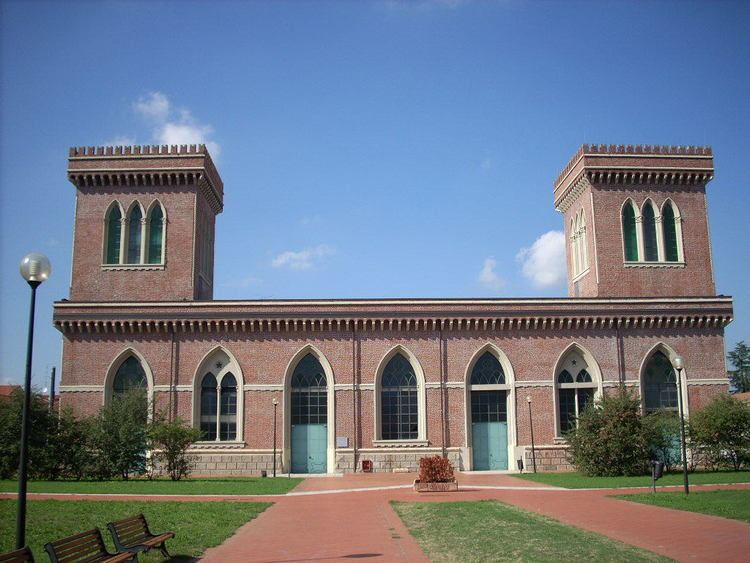Former names Cotonificio bustese Country Italy Renovated 1994 - 1997 Construction started 1857 | Town or city Busto Arsizio Completed 1896 Opened 1896 Phone +39 0331 390351 Architect Camillo Crespi Balbi | |
 | ||
Address Via Alessandro Volta, 6, 21052 Busto Arsizio VA, Italy Hours Open today · 3–7PMWednesday3–7PMThursday3–7PMFriday3–7PMSaturday3–7PMSunday10AM–12PM, 4–7PMMondayClosedTuesday3–7PMSuggest an edit Similar Parco Alto Milanese, Castellanza Train Station, Busto Arsizio railway st, Ferno‑Lonate Pozzolo railway st, Basilica di San Giovanni | ||
The Textiles Museum is one of the two museums in Busto Arsizio that specialises in spinning and weaving. It was opened in 1997 to house the objects, pictures and archive material representing Busto Arsizio's industrial history.
Contents
- The purpose of the Museum
- Ottolinis Cotton Mill
- Recent History of the Museum
- The Current Museum
- Ground Floor
- Spinning and preparation
- Weaving
- First Floor
- Jacquard
- Finishing Packaging and Delivery
- Second Floor
- Dyeing and Printing
- Embroidery and Schirpa
- Documents and Office
- Mechanical Textile Industry
- The Paracchi Archives
- The Shoe Making Industry
- References
The purpose of the Museum
The Museum aims to:
Ottolini’s Cotton Mill
The Museum is located in one of the town's oldest industrial districts; Ottolini’s Cotton Mill, in fact, is one of the first industrial settlements in Busto Arsizio which was built outside of the ancient centre of the former village, in the immediate vicinity of St. Michael's. The first project can be found in the National Archives of Varese in 1857. This building represents one of the best examples of the town’s industrial archaeology, wisely maintaining its original features. In 1896, the building was designed with the characteristics of a brick-built medieval castle, with lancet windows, towers and battlements.
Recent History of the Museum
On 19 January 1978, the Cotton Mill closed down the production because of the outdated equipment. The town of Busto Arsizio acquired the entire area and started the creation of a public park, and, in 1994, reconstruction of the main building was started. These works led to the establishment of the Museum as a reaction to the economical transformation in the area, to preserve objects and memories of everyday life and work as a cultural memory of the region.
The Current Museum
On 30 January 1997, after some years of restructuration, the Museum was officially reopened. The museum has three floors as well as two towers and gives the opportunity to follow a wide itinerary, connected with the textile production that was for a long period of time the proper pride of the local economy. The ground floor and the first floor are equipped with an alternative route which has been specially designed for the visually challenged.
Ground Floor
On the ground floor, in addition to a cafeteria and a conference room, there is also early spinning machinery, the large machines for weaving and finishing, and the first 19th-century systems for avoiding industrial accidents, such as fire estinguishers from the 19th century..
Spinning and preparation
In this area, near the hall, there is an old carding system and machinery framing used within the domestic system. On the walls there are paintings illustrating the textile manufacturing process.
Weaving
In the weaving department, there is the oldest and most important machine which deserves special attention as it originated from the old wood framing industry from 1813. This is a domestic hand loom used by peasant families. Finally, there is a department dedicated to the life of the workers, plus the two towers one of which is devoted to photography whilst the other explores the myths of the industrial factory in Busto Arsizio.
First Floor
The first floor is dedicated to the history of Jacquard manufacturing, from the original machinery to computers. This level is important for "the room of experiences", where you can touch the different stages of cotton preparation and you can also see the packaging and delivery of the products.
Jacquard
The Jacquard area showcases the different machines which were used for this specialist embroidery process.
Finishing, Packaging and Delivery
In the display cabinets and depicted in the paintings are the old samples and original labels used by the leading local manufacturers from the mid-19th and early 20th century.
Second Floor
On the second floor, you can see the stages of dyeing and printing fabric and you can also find many finished products, from specialised outfits of this century to new synthetic fibres. This includes astronaut uniform, Formula 1 jumpsuits and fashion clothing such as a Valentino dress.
Dyeing and Printing
This section shows the original process of dyeing using vegetable colours, also showcased area ancient samples and original notes from chemists and dyers from the Busto area as well as Swiss and German workers form the Cantoni cotton mill.
In the printing area, there is a display of hand printing works and techniques.
Embroidery and "Schirpa"
In the next room there is a display dedicated to "schirpa", which is the traditional dowry of brides in the Alto Milanese area using local fabrics. This includes lingerie, embroidered clothing, bedding, curtains and a tablecloth woven in the style of Leonardo. Also showcased is embroidery and lace from Gallarate.
Documents and Office
This area has old office equipment and a laboratory as well as projects, original documents and rare photographs of the interiors of the factories, workers and come of the most important entrepreneurs of the Busto region, such as Enrico dell'Acqua.
Mechanical Textile Industry
This section presents documents and memories of the factories that emerged as a mechanical induced production of textile machinery. It was built on site until 1870 when this was purchased abroad.
The Paracchi Archives
The archives include a collection of views of Busto Arsizio, "Bustesi" portraits and studio material dated form the late 19th century.
The Shoe-Making Industry
In this section, some items of the Borri footwear history are collected, which represent the evolution of production during the century-old history of this important firm.
